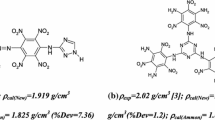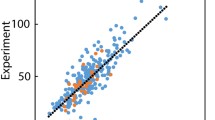Abstract
This paper reviews some recent developments for prediction of sublimation energy and deflagration temperature of energetic materials, which are important for the assessment of hazardous properties of these types of compounds. A novel user-friendly computer code, written in Visual Basic, is introduced to predict sublimation energy and deflagration temperature of energetic materials through using only their molecular structure parameters. It can be used for different types of energetic compounds including nitroaliphatics, nitroaromatics, nitramines and nitrate esters. The predicted results were compared with experimental data for some new energetic compounds of different classes containing complex molecular structures, which confirm high reliability of this novel computer code.

Similar content being viewed by others
References
Sikder AK, Maddala G, Agrawal JP, Singh H. Important aspects of behaviour of organic energetic compounds: a review. J Hazard Mater. 2001;84(1):1–26.
Agrawal JP. High energy materials: propellants, explosives and pyrotechnics. New York: Wiley; 2010.
Keshavarz MH. Research progress on heats of formation and detonation of energetic compounds. Hazardous materials: types, risks and control. New York: Nova Science Publishers; 2011. p. 339–59.
Keshavarz MH. Important aspects of sensitivity of energetic compounds: a simple novel approach to predict electric spark sensitivity. Explosive materials: classification, composition and properties. New York: Nova Science Publishers; 2011. p. 103–23.
Fried L, Howard W, Souers PC. Cheetah 2.0 User’s manual. Lawrence Livermore National Laboratory; 1998.
Muthurajan H, Sivabalan R, Talawar M, Asthana S. Computer simulation for prediction of performance and thermodynamic parameters of high energy materials. J Hazard Mater. 2004;112(1):17–33.
Keshavarz MH, Motamedoshariati H, Moghayadnia R, Nazari HR, Azarniamehraban J. A new computer code to evaluate detonation performance of high explosives and their thermochemical properties, part I. J Hazard Mater. 2009;172(2):1218–28.
Keshavarz MH, Motamedoshariati H, Moghayadnia R, Ghanbarzadeh M, Azarniamehraban J. A new computer code for assessment of energetic materials with crystal density, condensed phase enthalpy of formation, and activation energy of thermolysis. Propell Explos Pyrot. 2013;38(1):95–102.
Keshavarz MH, Motamedoshariati H, Moghayadnia R, Ghanbarzadeh M, Azarniamehraban J. Prediction of sensitivity of energetic compounds with a new computer code. Propell Explos Pyrot. 2014;39(1):95–101.
Gharagheizi F, Sattari M, Tirandazi B. Prediction of crystal lattice energy using enthalpy of sublimation: a group contribution-based model. Ind Eng Chem Res. 2011;50(4):2482–6.
Mathieu D. Simple alternative to neural networks for predicting sublimation enthalpies from fragment contributions. Ind Eng Chem Res. 2012;51(6):2814–9.
Atkins P. Physical chemistry. 6th ed. Oxford: Oxford University Press; 1998.
Keshavarz MH, Tehrani MK, Pouretedal H, Semnani A. New pathway for quick estimation of gas phase heat of formation of non-aromatic energetic compounds. Indian J Eng Mater S. 2006;13(6):542.
Keshavarz MH, Tehrani MK. A new method for determining gas phase heat of formation of aromatic energetic compounds. Propell Explos Pyrot. 2007;32(2):155–9.
Oftadeh M, Keshavarz MH, Khodadi R. Prediction of the condensed phase enthalpy of formation of nitroaromatic compounds using the estimated gas phase enthalpies of formation by the PM3 and B3LYP methods. Cent Eur J Energ Mater. 2014;11(1):143–56.
Rice BM, Pai SV, Hare J. Predicting heats of formation of energetic materials using quantum mechanical calculations. Combust Flame. 1999;118(3):445–58.
Politzer P, Murray JS, Edward Grice M, Desalvo M, Miller E. Calculation of heats of sublimation and solid phase heats of formation. Mol Phys. 1997;91(5):923–8.
Byrd EF, Rice BM. Improved prediction of heats of formation of energetic materials using quantum mechanical calculations. J Phys Chem A. 2006;110(3):1005–13.
Hu A, Larade B, Dudiy S, AbouRachid H, Lussier LS, Guo H. Theoretical prediction of heats of sublimation of energetic materials using pseudo atomic orbital density functional theory calculations. Propell Explos Pyrot. 2007;32(4):331–7.
Zeman S, Krupka M. Some predictions of the heats of fusion, heats of sublimation and lattice energies of energetic materials. HanNeng CaiLiao. 2002;10:27–33.
Keshavarz MH. Prediction of heats of sublimation of nitroaromatic compounds via their molecular structure. J Hazard Mater. 2008;151(2):499–506.
Keshavarz MH, Yousefi MH. Heats of sublimation of nitramines based on simple parameters. J Hazard Mater. 2008;152(3):929–33.
Keshavarz MH. Improved prediction of heats of sublimation of energetic compounds using their molecular structure. J Hazard Mater. 2010;177(1):648–59.
Yan Q-L, Zeman S, Šelešovský J, Svoboda R, Elbeih A. Thermal behavior and decomposition kinetics of Formex-bonded explosives containing different cyclic nitramines. J Therm Anal Calorim. 2013;111(2):1419–30.
Yan Q-L, Zeman S, Elbeih A, Song Z-W, Málek J. The effect of crystal structure on the thermal reactivity of CL-20 and its C4 bonded explosives (I): thermodynamic properties and decomposition kinetics. J Therm Anal Calorim. 2013;112(2):823–36.
Zhang G, Zheng H, Xiang X. Thermal decomposition and kinetics studies on the 2,2-dinitropropyl acrylate–styrene copolymer and 2,2-dinitropropyl acrylate–vinyl acetate copolymer. J Therm Anal Calorim. 2013;111(2):1039–44.
Wang Q, Wang J, Larranaga MD. Simple relationship for predicting onset temperatures of nitro compounds in thermal explosions. J Therm Anal Calorim. 2013;111(2):1033–7.
Trache D, Khimeche K. Study on the influence of ageing on chemical and mechanical properties of N,N′-dimethyl-N,N′-diphenylcarbamide stabilized propellants. J Therm Anal Calorim. 2013;111(1):305–12.
Zeman S. Analysis and prediction of the Arrhenius parameters of low-temperature thermolysis of nitramines by means of the 15 N NMR spectroscopy. Thermochim Acta. 1999;333(2):121–9.
Zeman S. New aspects of initiation reactivities of energetic materials demonstrated on nitramines. J Hazard Mater. 2006;132(2):155–64.
Zeman S, Friedl Z. Relationship between electronic charges at nitrogen atoms of nitro groups and thermal reactivity of nitramines. J Therm Anal Calorim. 2004;77(1):217–24.
Oftadeh M, Khozani MH, Radhoosh M, Keshavarz MH. DFT molecular orbital calculations of initial step in decomposition pathways of TNAZ and some of its derivatives with –F, –CN and –OCH 3 groups. Comput Theor Chem. 2011;964(1):262–8.
Oftadeh M, Selahvarzi S, Keshavarz MH. Intermolecular Interactions between TNAZ and H2O: a DFT study. Cent Eur J Energ Mater. 2013;10:289–300.
Sorescu DC, Rice BM, Thompson DL. Molecular packing and molecular dynamics study of the transferability of a generalized nitramine intermolecular potential to non-nitramine crystals. J Phys Chem A. 1999;103(8):989–98.
Zeman S, Roháč M. Technologically attractive high thermostable polynitro arenes. HanNeng CaiLiao. 2006;14(5):361–6.
Keshavarz MH, Reza Pouretedal H, Sadeghi H, Semnani A. Relationship between the low temperature thermolysis and detonation temperature of carbocyclic nitroaromatic compounds. Propell Explos Pyrot. 2009;34(5):415–20.
Zeman S. Modified Evans–Polanyi–Semenov relationship in the study of chemical micromechanism governing detonation initiation of individual energetic materials. Thermochim Acta. 2002;384(1):137–54.
Keshavarz MH, Pouretedal HR, Shokrolahi A, Zali A, Semnani A. Predicting activation energy of thermolysis of polynitro arenes through molecular structure. J Hazard Mater. 2008;160(1):142–7.
Keshavarz MH. Simple method for prediction of activation energies of the thermal decomposition of nitramines. J Hazard Mater. 2009;162(2):1557–62.
Keshavarz M. A new method to predict activation energies of nitroparaffins. Indian J Eng Mater S. 2009; 6.
Fedoroff BT, Aaronson HA, Reese EF, Sheffield OS, Cliff GO. Encyclopedia of explosives and related items. PATR 2700. Dover: Picatinny Arsenal; 1960.
Keshavarz MH, Moradi S, Saatluo BE, Rahimi H, Madram AR. A simple accurate model for prediction of deflagration temperature of energetic compounds. J Therm Anal Calorim. 2013;112(3):1453–63.
Zohari N, Keshavarz MH, Seyedsadjadi SA. The advantages and shortcomings of using nano-sized energetic materials. Cent Eur J Energ Mater. 2013;10:135–47.
NIST Standard Reference Data Base Number 69, which can be accessed electronically through the NIST Chemistry Web Book http://webbook.nist.gov/chemistry/, references for individual molecules are given therein.
Davis TL. The chemistry of powder and explosives. New York: Wiley; 1956.
Teipel U. Energetic materials, particle processing and characterization. Weinheim: Wiley; 2005.
Meyer R, Köhler J, Homburg A. Explosives. 5th ed. Weinheim: Wiley; 2002.
Türker L, Variş S. A review of polycyclic aromatic energetic materials. Polycyclic Aromat Compd. 2009;29(4):228–66.
Mehilal Sikder A, Salunke R, Sikder N. Nitroanilinodinitrobenzofuroxans—synthesis, characterisation, thermal stability and explosive properties. New J Chem. 2001;25(12):1549–52.
Mehilal, Sikder N, Sikder AK, JP A. N,N′-Bis(1,2,4-triazol-3yl)-4,4′-diamino-2,2′,3,3′,5,5′,6,6′-octanitroazobenzene (BTDAONAB): a new thermally stable insensitive high explosive. Indian J Eng Mater Sci. 2004; 11:516–20.
Fedoroff BT, Sheffield OE, Reese EF, Clift GD. Encyclopedia of explosives and related items. Part 2700. Picatinny Arsenal: Dower, NJ; 1962.
Mousavi S, Esmaeilpour K, Keshavarz MH. A new thermally-stable insensitive high explosive: N,N′-Bis(1,2,3,4-tetrazol-5-yl)-4,4′-diamino-2,2′,3,3′,5,5′,6,6′-octanitroazobenzene (BTeDAONAB). Cent Eur J Energ Mater. 2013;10.
Acknowledgements
We would like to thank the research committee of Malek-ashtar University of Technology (MUT) for supporting this work.
Author information
Authors and Affiliations
Corresponding author
Rights and permissions
About this article
Cite this article
Keshavarz, M.H., Ghani, K. & Asgari, A. A suitable computer code for prediction of sublimation energy and deflagration temperature of energetic materials. J Therm Anal Calorim 121, 675–681 (2015). https://doi.org/10.1007/s10973-015-4622-0
Received:
Accepted:
Published:
Issue Date:
DOI: https://doi.org/10.1007/s10973-015-4622-0




